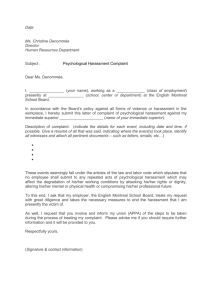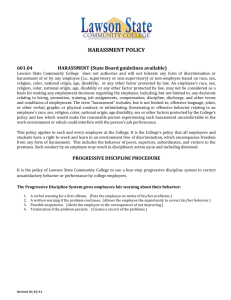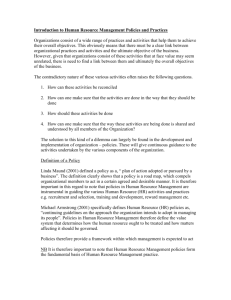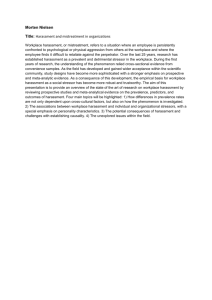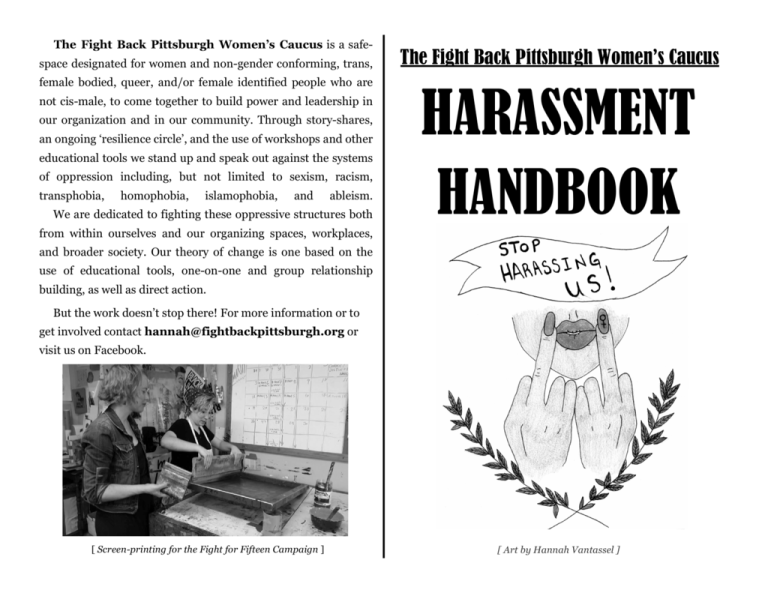
The Fight Back Pittsburgh Women’s Caucus is a safespace designated for women and non-gender conforming, trans,
female bodied, queer, and/or female identified people who are
not cis-male, to come together to build power and leadership in
our organization and in our community. Through story-shares,
an ongoing ‘resilience circle’, and the use of workshops and other
educational tools we stand up and speak out against the systems
of oppression including, but not limited to sexism, racism,
transphobia,
homophobia,
islamophobia,
and
ableism.
We are dedicated to fighting these oppressive structures both
from within ourselves and our organizing spaces, workplaces,
The Fight Back Pittsburgh Women’s Caucus
HARASSMENT
HANDBOOK
and broader society. Our theory of change is one based on the
use of educational tools, one-on-one and group relationship
building, as well as direct action.
But the work doesn’t stop there! For more information or to
get involved contact hannah@fightbackpittsburgh.org or
visit us on Facebook.
[ Screen-printing for the Fight for Fifteen Campaign ]
[ Art by Hannah Vantassel ]
Identifying Harassment
Street harassment is not new and it is not uncommon. Street
harassment is performed in a public place, and is often sexually
motivated. However, the harassment’s title doesn’t really do this
harmful social norm justice. This behavior can occur in any
public place (i.e. the mall, the pool, the bar), and using the word
“street” can make the harassment seem minor and tame. It
paints a picture of seedy street corners in big dirty cities, where
the scummiest men prey upon young ladies. It implies that street
harassment does not cause harm to the victim.
But that is not an accurate scope of the issue. People of all
gender identities suffer greatly from public harassment. From
walking to work in a t-shirt and jeans, to having a nice night out
with friends at a club, to simply existing in the same space as the
harasser can have a massive impact.
Sometime we don’t realize we are being harassed until part of
the way through the interaction. If you are being made physically
or emotionally uncomfortable by the person/people, then you are
being harassed. These are 3 warning signs to determine if a
situation is escalating into harassment:
1. Is someone impeding in your personal space?
2. Is the way someone is speaking or looking at you making
you uncomfortable? Is there an innuendo in what is being
said?
3. After you have given a clear sign you do not wish to engage
(silence, ignoring, yelling, etc.), does the person continue
Remember: you don’t owe anyone anything.
The Women’s Caucus of Fight Back Pittsburgh began the
“Stop Harassing Us” campaign exclusively to help educate and
unite people in the fight to end public harassment once and for all!
3. You see a woman you find attractive walking down the street
wearing heels, a short skirt, and a revealing top. You should:
a.) Let her know you have noticed her good looks by
scanning your gaze up and down her body, smiling
suggestively and saying “yeah girl,” giving shout-outs to
specific body parts that pique your interest, etc. Be
creative! Howling, whistling, barking, panting, or making
up little dirty limericks right on the spot are all
encouraged. Remember even a simple “hello” can
communicate “I want to rip off your clothes and bend you
over right now” with the right inflection. Women don’t
dress for themselves, they put on those clothes and look
that way for your benefit! So make sure you let them
know you appreciate it!
b.) Smile and nod politely as she walks by, or do and say
nothing.
c.) Remind her that dressing like that is inappropriate and
dangerous by expressing your paternal concern for her
own good.
d.) Wait until she walks past and then pointedly stare at
her ass. For max benefit, make sure other people around
you notice what you are doing. She’s putting it on display!
Enjoy it!
4. You see another human being. You should:
a.) Treat them like a sex object.
b.) Expect that they will comply with fulfilling your own
needs and a desires, be it for company, comfort, validation
or sexual release.
c.) Treat them like another human being.
d.) Be a jerk.
Answers: 1) c 2) a 3) b 4) c
If you got more than zero of these wrong, take a long, hard look at your
actions
Harassment Prevention Test
How to Respond to Harassment
1. If you attempt to engage a woman in small talk and she
ignores you or tells you she cannot or is not interested in talking
at the moment, you should:
a.) Continue trying to engage her in conversation. Stare
at her face and move to be in her line of sight as you do.
Buy her a drink if you can. Follow her if you must.
Haven’t you seen the Rom-coms? The men who blatantly
disregard a woman’s boundaries are always the ones who
get the chicks! Movies never lie.
b.) Express your anger and disapproval. Women exist to
make you feel good and they need to be reminded of this.
Who does she think she is? Another human?
c.) Respect her desires and needs by ceasing talking to
her and letting her be.
d.) Wonder out loud what is wrong with her. She is
supposed to respond pleasantly to you and be grateful a
man wants to give her attention. This is another win-win
because it’s like giving her free therapy!
Remember: There is no one correct way to respond to
harassment
2. You see two people holding hands and acting in love who do
not seem to be a man and a woman. You should:
a.) Act no differently towards them than you would any
other couple.
b.) Make a remark that communicates your prejudice -er,
belief- that sexual and romantic love should be between a
man and woman only.
c.) Stare. Keep staring. Stare some more. More staring
d.) Tell them you find them sexy and ask what they are
doing later that night.
However, we do like to keep the following phrases in our back
pocket for when jagoffs can’t handle a no.
You being here
makes me want to do anything
but smile…
I’m not here for you to
stare at!
You can also take their picture, or a picture of their license if
they’re in a car. This is useful both for ID-ing them and scaring
them off. Remember that ignoring them is always an acceptable
option.
If you’re feeling
particularly spirited, try
responding to their
comment with your best
velociraptor impression.
[ Art by Hannah Vantassel ]
Aftercare
Fighting Back Continued
[ Art by
Hannah
Vantassel ]
Dealing with public harassment could leave you feeling
annoyed, unnerved, frustrated, or scared. It is important that you
take care of yourself after dealing with harassment. Here are
some suggestions of what to do after facing a harasser:
Get to a safe space! Safe spaces look different
based on the person and the situation. You could:
✓Cross the street
✓Go inside the nearest store/restaurant/etc.
✓Make your way to your house, or to a friend’s house
if
you know they are home.
✓Stay where you are. You are entitled to your space.
Recurrent harassment is likely to escalate, so don’t feel bad
about putting it on the books so you can seek out a restraining
order if need be. You can also call the National Sexual Assault
hotline, 800.656.HOPE (4673), which can help you find health
and legal support from local agencies personalized to your
situation. You can also report your story online via [Fight Back
site…] or http://www.ihollaback.org/about/the-movement/ .
3. In safer situations, take back the streets by calling out the
aggressor. See: “Responding to Public Harassment”
4. If you need help from someone around you, you can avoid
the bystander effect—when bystanders won’t offer any assistance
under the often false assumption somebody else will—by making
eye-contact and asking one particular person for help. Tell them
exactly what you need, i.e. helping you move away from the
situation into a more crowded area, calling others for help,
pretending they know you, etc.
5. Seek aftercare! See: “Aftercare Resources”
[ Legal information from stopstreetharassment.org. ]
Call someone you trust! Whether it’s to vent or to
feel safe on the rest of your journey, talking to a trusted
friend is always a good idea.
Talk about it! Tell people your story. It could be in
person, on social media, or on a blog. Let people know
that street harassment is a systemic problem that
happens all too often. It’s always okay to not want to talk
about it at first, or at all! The idea is to put the power
back in your hands, and regain your sense of safety.
[ Art by Hannah
Vantassel ]
Fighting Back
First Things First:
It is not your fault you’re being attacked. It’s not about how
you dressed or how you dared to step outside alone as a woman,
and it’s also not your fault if you can’t respond in the “best” way
while you are being attacked.
If you are attacked:
1. Assess the situation - Your response may be different if
you are in a desolate area, or if it’s night. If you feel you are
in an imminently dangerous situation, trust your gut and
call for help immediately. If your phone is dead, you can
loudly pretend someone knows where you are and has a
description of what’s happening. Leave for a more public
area if you are able.
2. Know your legal rights - Unfortunately, police have a
horrid record of responding to sexual violence, especially for
people of color and queer folks. Or, you may not want to become
complicit in our society’s ugly criminal justice system for many
other reasons. However, it’s still helpful to know your rights and
the legal status of your harasser’s actions towards you, as you
may be able to use it to make them stop.
In Pennsylvania, explicitly illegal forms of harassment
include following someone, subjecting or threatening to subject
someone to physical contact, engaging “in a course of conduct or
repeatedly committing acts which serve no legitimate purpose”,
and “communicating to or about someone any lewd, lascivious,
threatening or obscene words, language, drawings or
caricatures.” Remember, police are legally required to take your
testimony and help you. If they are uncooperative, tell them if
they don’t want to carry out their duty you want to speak to
someone who can.
Resources
There are tons of resources available for aftercare of street
harassment. Know you are not alone! Here are a few online
and in-person resources at your disposal:
• www.stopstreetharassment.org
o Stop Street Harassment (SSH) is a nonprofit
organization dedicated to documenting,
addressing, and ending gender-based street
harassment worldwide.
• www.ihollaback.org .
o Hollaback is a movement to end street
harassment powered by a network of local
activists around the world. We work together to
better understand street harassment, to ignite
public conversations, and to develop innovative
strategies to ensure equal access to public
spaces.
• www.paar.net 1-866-END-RAPE
o PAAR (Pittsburgh Action Against Rape) is one
of the oldest rape crisis centers in the U.S., and
the only organization in Allegheny County
solely devoted to the issue of sexual violence.
• Fight Back Pittsburgh’s Women’s Caucus
o Contact hannah@fightbackpittsburgh.org,
check out our Facebook page, or report your
incident at fightbackpittsburgh.org/womens-
[ Art by
Tatyana
Fazlalizadeh ]
Being a Bystander
The bystander effect, or bystander apathy, is a socialpsychological phenomenon that refers to cases in which
individuals do not offer any means of help to a victim when other
people are present. The this effect is a real problem in terms of
public harassment. How often have you seen someone harassed
on the street or the bus? How often have you put yourself out
there to read the situation and stop it? These are questions we
have to ask ourselves to make sure we aren’t part of the problem.
By acting as if nothing is wrong, you are active in normalizing
this behavior. If you feel like it would be dangerous for you to get
involved, you can still help by getting another bystander to help
you or using your phone to call for backup if nobody else is
around. Here is a guide to take action when you see public
harassment.
• Check in with the target
o A simple “Are you okay?”, “Is this person bothering
you?”, or “Do you want me to call anyone?” is often
enough to stop the harassment.
• If they respond that they do not need help, it may
be because they have the situation under control, think
there is nothing you can do to help, or may not trust you.
If you identify as a man, be careful not to add to the
harassment. Respect them and let them know if the
situation changes you would still want to help. Never put
yourself in danger; it is not your responsibility to be
someone’s hero.
Being a Bystander Continued
• Assess the situation and call out the harasser
o Let the harasser know that what they are doing is
socially unacceptable!
§ “Would you talk to me that way?”
§ “Stop! What are you even doing? That’s not cool.”
§ “Are you serious?”
• Stand up to your friends
o If you see a friend harassing someone, don’t be a silent
participant! Let them know what they are doing isn’t
funny or acceptable.
Having a bystander say or do something to stop the harassment
makes a big difference for the victim of harassment.
Do your part to stop public harassment!
A Note to Cis-Men:
Being a good ally means using your position of privilege
to call out other men who may not listen to women.
[ Art by Hannah Vantassel ]

